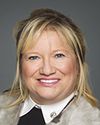In the 38 communities in which your members operate, is that as prevalent? Are aboriginal women more likely to come forward to an aboriginal police service, or are the numbers still, unfortunately, very low? Is there a disparity between whether that community was served by the RCMP or by a provincial police force, or whether it's served by a first nations policing authority? Do you know if there's any evidence that there are higher levels of reporting when there are incidents of violence?
Evidence of meeting #2 for Special Committee on Violence Against Indigenous Women in the 41st Parliament, 2nd Session. (The original version is on Parliament’s site, as are the minutes.) The winning word was communities.
A recording is available from Parliament.




